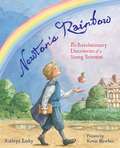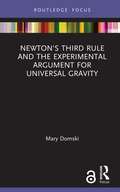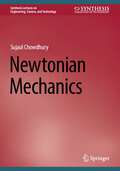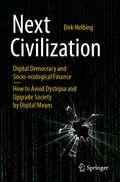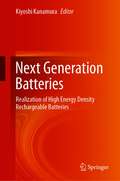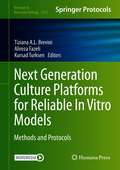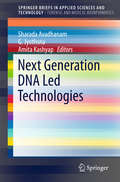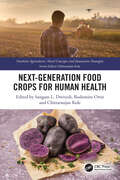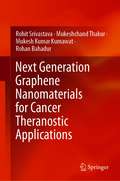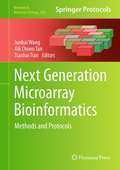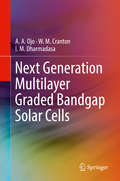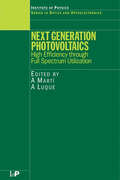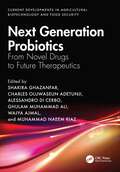- Table View
- List View
Newton's Gravity
by Douglas W. Macdougal"Newton's Gravity" conveys the power of simple mathematics to tell the fundamental truth about nature. Many people, for example, know the tides are caused by the pull of the Moon and to a lesser extent the Sun. But very few can explain exactly how and why that happens. Fewer still can calculate the actual pulls of the Moon and Sun on the oceans. This book shows in clear detail how to do this with simple tools. It uniquely crosses disciplines - history, astronomy, physics and mathematics - and takes pains to explain things frequently passed over or taken for granted in other books. Using a problem-based approach, "Newton's Gravity" explores the surprisingly basic mathematics behind gravity, the most fundamental force that governs the movements of satellites, planets, and the stars. Author Douglas W. MacDougal uses actual problems from the history of astronomy, as well as original examples, to deepen understanding of how discoveries were made and what they mean. "Newton's Gravity" concentrates strongly on the development of the science of orbital motion, beginning with Galileo, Kepler, and Newton, each of whom is prominently represented. Quotes and problems from Galileo's Dialogs Concerning Two New Sciences and particularly Newton's Principia help the reader get inside the mind of those thinkers and see the problems as they saw them, and experience their concise and typically eloquent writing. This book enables students and curious minds to explore the mysteries of celestial motion without having to know advanced mathematics. It will whet the reader's curiosity to explore further and provide him or her the tools (mathematical or physical) to do so.
Newton's Laws: A Fairy Tale
by Sarah AllenSarah Allen is a fantasy novelist and professional math and physics tutor. In her Fairy Tale Physics series, Sarah has combined her talents into something you’ve never seen before. <p><p> Each Fairy Tale Physics book is a delightful illustrated story that introduces and explores physics concepts in a way that anyone can understand. <p><p> In Newton’s Laws: A Fairy Tale, you’ll read about young Kip, whose only inheritance from his father is a single apple. Always the optimist, Kip strikes out into the world to seek his fortune, and meets a wizard with mysterious plans… <p><p> Kip’s adventure is packed with situations that introduce us to some of the foundations of physics: Newton’s laws of motion. But not only will you learn physics alongside Kip – there’s a bonus section on problem solving at the end, with over 30 exercises that tie the lessons of the story concretely to what you might learn in a physics class in high school or college. Also included are links to Sarah’s favorite physics resources: videos, articles, and online simulations that you can play with to learn more. <p><p> Newton’s Laws: A Fairy Tale is for you if: <p> You are curious about physics. <p>You are a parent looking to introduce physics concepts to your child. <p>You are taking your first AP or college physics course. <p>You are intrigued by a fairy tale that holds something unique and special! <p><p>This is book one in the Fairy Tale Physics Series. It covers Newton's Three Laws, Free Body Diagrams, Net Force, Acceleration, and Forces. Enjoy!
Newton's Philosophy of Nature: Selections from His Writings
by Sir Isaac Newton H. S. ThayerAside from the Principia and occasional appearances of the Opticks, Newton's writings have remained largely inaccessible to students of philosophy, science, and literature as well as to other readers. This book provides a remedy with wide representation of the interests, problems, and diverse philosophic issues that preoccupied the greatest scientific mind of the seventeenth century.Grouped in sections corresponding to methods, principles, and theological considerations, these selections feature cross-references to related essays. Starting with an examination of the methods of natural philosophy--including the rules of reasoning, the formulation of hypotheses, and the experimental method--the essays explore the laws of motion and the relationships between God and gravity, creation, and universal design. Discussions of questions related to natural philosophy include theories on light, colors, and perceptions. The volume concludes with absorbing selections from the Opticks and a helpful series of historical and explanatory notes.
Newton's Rainbow: The Revolutionary Discoveries of a Young Scientist
by Kathryn LaskyThis book tells the story of young Isaac—always reading, questioning, observing, and inventing—and how he eventually made his way to Cambridge University, where he studied the work of earlier scientists and began building on their accomplishments. The book celebrates Newton's discoveries that illuminated the mysteries of gravity, motion, and even rainbows, discoveries that gave mankind a new understanding of the natural world, discoveries that changed science forever.
Newton's Third Rule and the Experimental Argument for Universal Gravity (Routledge Focus on Philosophy)
by Mary DomskiThis book provides a reading of Newton’s argument for universal gravity that is focused on the evidence-based, "experimental" reasoning that Newton associates with his program of experimental philosophy. It highlights the richness and complexity of the Principia and also draws important lessons about how to situate Newton in his natural philosophical context. The book has two primary objectives. First, it defends a novel interpretation of the third of Newton’s four Rules for the Study of Natural Philosophy – what the author terms the Two-Set Reading of Rule 3. Second, it argues that this novel interpretation of Rule 3 sheds additional light on the differences between Newton’s experimental philosophy and Descartes’s "hypothetical philosophy," and that it also illuminates how the practice of experimental philosophy allowed Newton to make a universal force of gravity the centerpiece of his explanation of the system of the world. Newton’s Third Rule and the Experimental Argument for Universal Gravity will be of interest to researchers and advanced students working on Newton’s natural philosophy, early modern philosophy, and the history of science.
Newton: A Very Short Introduction
by Robert IliffeNewton's reputation was the subject of intense debate long before his death in 1727. While alive, numerous opponents sought to topple his theories, and his views on religion were considered by many to be unorthodox. For the vast majority of scholars, however, his groundbreaking approach to science overrode all else. This book makes use of previously unpublished private writings and manuscript sources to present a concise exploration of the internal springs of Newton's complex character. Robert Iliffe describes Newton's studies in fields ranging from alchemy, physics, and mathematics, as well as his controversial religious beliefs, and concludes with a consideration of the legacy left after his demise. Newton will gratify readers who are interested in the real history behind one of the world's most legendary scientists.
Newtonian Dynamics: An Introduction
by Richard FitzpatrickThis textbook provides a comprehensive review of Newtonian dynamics at a level suitable for undergraduate physics students. It demonstrates that Newton’s three laws of motion, combined with a few simple force laws, can not only describe the motions of everyday objects observed on the surface of the Earth, but can also account for the motions of celestial objects seen in the sky. It helps bridge the problematic transition between elementary physics courses and upper-division physics course. The book will start off at a level suitable for undergraduate (freshman) physics students and will very gradually increase, until, towards the end, it will approach (but not quite reach) a level characteristic of a graduate (senior) physics course. Each chapter of the book will end with a large number of numerical and analytical exercises and, in all appropriate cases, the final answers to the exercises will be specified. The large number of exercises will allow students to accurately test their understanding of the material presented in the book, ideal for students who are self-studying or are taking classes remotely. Key features: Provides a brief and accessible introduction to a complex topic. Contains a thorough treatment of the motions of heavenly bodies than conventional elementary mechanics texts. Provides a wealth of end-of-chapter exercises to test understanding.
Newtonian Mechanics (Synthesis Lectures on Engineering, Science, and Technology)
by Sujaul ChowdhuryThis book discusses topics related to Newtonian mechanics and is ideal for a one semester course. Introductory topics are first presented including: time, space, and matter; different coordinate systems; vectors; and unit vectors;. The author presents tools such as displacement, velocity, and acceleration to describe projectile motion and uniform circular motion. Newton’s laws of motion and concepts of force and mass are discussed followed by kinetic energy, potential energy, and both conservative and non-conservative forces. This class-tested book also introduces angular displacement, angular speed, and angular acceleration as well as the use of these to describe the motion of particles with constant angular acceleration. Concepts of torque, angular momentum, and rotational inertia are presented to explain the motion of physical pendulum. Motion under central force is also covered and Kepler’s laws are derived.
Newtonian Physics
by Benjamin CrowellA volume in the open source textbook physics series Light and Matter.
Newton’s Sensorium: Anatomy of a Concept (Archimedes Ser. #53)
by Jamie C. KasslerThese chapters analyze texts from Isaac Newton’s work to shed new light on scientific understanding at his time. Newton used the concept of “sensorium” in writings intended for a public audience, in relation to both humans and God, but even today there is no consensus about the meaning of his term. The literal definition of the Latin term 'sensorium', or its English equivalent 'sensory', is 'thing that feels’ but this is a theoretical construct.The book takes readers on a process of discovery, through inquiry into both Newton’s concept and its underlying model. It begins with the human sensorium. This part of his concept is situated in the context of the aforesaid writings but also in the context of the writings of two of Newton's contemporaries, the physicians William Briggs and Thomas Willis, both of whom were at the forefront of their respective specialties of ophthalmology and neurology. Only once the human sensorium has been explored is it possible to generalize to the unobservable divine sensorium, because Newton's method of reasoning from experience requires that the second part of his concept is last in the order of knowledge. And the reason for this sequence is that his method, the short-hand term for which is 'analogy of nature', proceeds from that which has been observed to be universally true to that which is beyond the limits of observation. Consequently, generalization passes insensibly into reasoning by analogy.Readers will see how certain widespread assumptions can be called into question, such as that Newton was a theological voluntarist for whom the will is superior to the intellect, or that, for Newton, not only the world or universe but also God occupies the whole extent of infinite space. The insights afforded through this book will appeal to scholars of the philosophy of science, human physiology, philosophy of mind and epistemology, among others.
Next Civilization: Digital Democracy and Socio-Ecological Finance - How to Avoid Dystopia and Upgrade Society by Digital Means
by Dirk Helbing"Digital transformation" sounds harmless, given that the explosion in data volumes, processing power and Artificial Intelligence has driven humanity and the entire world to a point of no return. We will surely see a new civilization, but we are at a crossroads. The future needs to be re-invented, decisions must be taken. After the automation of factories and the creation of self-driving cars, the automation of society is on its way. But there are two kinds of automation: a centralized top-down control of the world and a distributed control approach, supporting local self-organization. Using the power of today’s information systems, governments and big tech companies seem to engage in the first approach. Might they even build a „digital Crystal Ball“ that knows almost everything, including your personality, and a super-intelligent "digital God“ to control what we do? We are much closer to such „science fiction scenarios“ than you probably think. In this much expanded second edition of "The Automation of Society is Next: How to Survive the Digital Revolution" (2015), the author discusses lessons learned on digital democracy, aspects of transhumanism and far-reaching thoughts about life in the digital age and what it may mean to be human in the future.
Next Gen PhD
by Melanie V. SincheAn upper-level degree is a prized asset in the eyes of many employers, and nonfaculty careers once considered Plan B are now preferred by the majority of science degree holders. Melanie Sinche profiles science PhDs across a wide range of disciplines who share proven strategies for landing a rewarding occupation inside or outside the university.
Next Generation Batteries: Realization of High Energy Density Rechargeable Batteries
by Kiyoshi KanamuraIn this book, the development of next-generation batteries is introduced. Included are reports of investigations to realize high energy density batteries: Li-air, Li-sulfur, and all solid-state and metal anode (Mg, Al, Zn) batteries. Sulfide and oxide solid electrolytes are also reviewed.A number of relevant aspects of all solid-state batteries with a carbon anode or Li-metal anode are discussed and described: The formation of the cathode; the interface between the cathode (anode) and electrolyte; the discharge and charge mechanisms of the Li-air battery; the electrolyte system for the Li-air battery; and cell construction. The Li-sulfur battery involves a critical problem, namely, the dissolution of intermediates of sulfur during the discharge process. Here, new electrolyte systems for the suppression of intermediate dissolution are discussed. Li-metal batteries with liquid electrolytes also present a significant problem: the dendrite formation of lithium. New separators and electrolytes are introduced to improve the safety and rechargeability of the Li-metal anode. Mg, Al, and Zn metal anodes have been also applied to rechargeable batteries, and in this book, new metal anode batteries are introduced as the generation-after-next batteries.This volume is a summary of ALCA-SPRING projects, which constitute the most extensive research for next-generation batteries in Japan. The work presented in this book is highly informative and useful not only for battery researchers but also for researchers in the fields of electric vehicles and energy storage.
Next Generation Culture Platforms for Reliable In Vitro Models: Methods and Protocols (Methods in Molecular Biology #2273)
by Kursad Turksen Alireza Fazeli Tiziana A. L. BreviniThis detailed book collects original protocols aimed at encouraging and stimulating the scientific community to design and produce models for the laboratory that mimic cell guidance conditions as they occur in vivo. The protocols collected describe powerful strategies to exploit chemical cues involved in cell differentiation processes. Special emphasis is given to the use of methods for purification and characterization of exosomes and other secreted vesicles, as well as micro and non-coding RNAs, that have been demonstrated to control the tuning of the in vivo micro and macro environment in order to ensure the optimal soluble environment in vitro. Written for the highly successful Methods in Molecular Biology series, chapters include introductions to their respective topics, lists of the necessary materials and reagents, step-by-step, readily reproducible laboratory protocols, and tips on troubleshooting and avoiding known pitfalls. Authoritative and practical, Next Generation Culture Platforms for Reliable In Vitro Models: Methods and Protocols serves as an ideal guide for researchers working toward developing these vital testing models for preclinical studies.
Next Generation DNA Led Technologies
by Sharada Avadhanam G. Jyothsna Amita KashyapThis brief highlights advances in DNA technologies and their wider applications. DNA is the source of life and has been studied since a generation, but very little is known as yet. Several sophisticated technologies of the current era have laid their foundations on the principle of DNA based mechanisms. DNA based technologies are bringing a new revolution of Advanced Science and Technology. Forensic Investigation, Medical Diagnosis, Paternity Disputes, Individual Identity, Health insurance, Motor Insurance have incorporated the DNA testing and profiling technologies for settling the issues.
Next Generation Food Crops for Human Health (Nextgen Agriculture)
by Chittaranjan Kole Rodomiro Ortiz Sangam L. DwivediAs the global population surges, the challenge of feeding the world becomes increasingly urgent. Meeting this demand requires doubling crop yields and delivering safe, nutritious, and affordable food, but current agricultural practices fall short in combating malnutrition, climate change impacts, and the decline in food diversity.Next-Generation Food Crops for Human Health delves into the advances in genetic and genomic research that are revolutionizing the development of productive, nutrient-dense food crops. It presents insights into tools including high-throughput phenomics, DNA sequencing, and genomic selection, which enable scientists to discover functionally characterized genes and enhance staple crops, such as grains, legumes, fruits, vegetables, and oil crops. By leveraging these technologies, researchers are creating a new generation of foods that optimize essential nutrients, from complex carbohydrates and proteins to vitamins and bioactive compounds.A volume in the Nextgen Agriculture: Novel Concepts and Innovative Strategies series, this book is valuable to graduate and postgraduate students, postdoctoral researchers, and policymakers working toward improving nutritional security worldwide.
Next Generation Graphene Nanomaterials for Cancer Theranostic Applications
by Rohit Srivastava Mukeshchand Thakur Mukesh Kumar Kumawat Rohan BahadurThis book focuses on the use of graphene and its derivatives for application in cancer diagnosis and therapy. Readers are introduced to graphene nanomaterial history, synthesis procedures, properties, modifications, and applications in cancer research and development. The wide-ranging properties of graphene nanomaterials can be utilized for various cancer therapeutic and diagnostic applications. The contents discuss these applications with simple graphical overviews and provide comprehensive detail for a better understanding of the state of the art. The book will be of interest to professionals and academic researchers alike.
Next Generation Microarray Bioinformatics
by Junbai Wang Tianhai Tian Aik Choon TanRecent improvements in the efficiency, quality, and cost of genome-wide sequencing have prompted biologists and biomedical researchers to move away from microarray-based technology to ultra high-throughput, massively parallel genomic sequencing (Next Generation Sequencing, NGS) technology. In Next Generation Microarray Bioinformatics: Methods and Protocols, expert researchers in the field provide techniques to bring together current computational and statistical methods to analyze and interpreting both microarray and NGS data. These methods and techniques include resources for microarray bioinformatics, microarray data analysis, microarray bioinformatics in systems biology, next generation sequencing data analysis, and emerging applications of microarray and next generation sequencing. Written in the highly successful Methods in Molecular BiologyTM series format, the chapters include the kind of detailed description and implementation advice that is crucial for getting optimal results in the laboratory. Authoritative and practical, Next Generation Microarray Bioinformatics: Methods and Protocols seeks to aid scientists in the further study of this crucially important research into the human DNA.
Next Generation Middle Grade Science 2019 Earth Student Edition Grade 6
by Prentice-Hall StaffElevate Middle Grade Science 2019 Engineering Design Notebook Grade 6
Next Generation Middle Grade Science: Grade 6
by Prentice-Hall StaffElevate Middle Grade Science 2019 Student Edition Grade 6
Next Generation Multilayer Graded Bandgap Solar Cells
by A. A. Ojo W. M. Cranton I. M. DharmadasaThis book will guide Photovoltaics researchers in a new way of thinking about harvesting light energy from all wavelengths of the solar spectrum. It closes the gap between general solar cells books and photovoltaics journal articles, by focusing on the latest developments in our understanding of solid-state device physics. The material presented is experimental and based on II-VI thin-film materials, mainly CdTe-based solar cells. The authors describe the use of new device design, based on multilayer graded bandgap configuration, using CdTe-based solar cells. The authors also explain how the photo-generated currents can be enhanced using multi-step charge carrier production. The possibility of fabricating these devices using low-cost and scalable electroplating is demonstrated. The value of electroplating for large area electronic devices such as PV solar panels, display devices and nano-technology devices are also demonstrated. By enabling new understanding of the engineering of electroplated semiconductor materials and providing an overview of the semiconductor physics and technology, this practical book is ideal to guide researchers, engineers, and manufacturers on future solar cell device designs and fabrications.Discusses in detail the processes of growths, treatments, solar cell device fabrication and solid state physics, improving readers’ understanding of fundamental solid state physics;Enables future improvements in CdTe-based device efficiency;Explains the significance of defects in deposited semiconductor materials and interfaces that affect the material properties and resulting device performance.
Next Generation Photovoltaics: High Efficiency through Full Spectrum Utilization (Series in Optics and Optoelectronics)
by Antonio Mart and Antonio LuqueAlthough photovoltaics are regarded by many as the most likely candidate for long term sustainable energy production, their implementation has been restricted by the high costs involved. Nevertheless, the theoretical limit on photovoltaic energy conversion efficiency-above 85%-suggests that there is room for substantial improvement of current comme
Next Generation Probiotics: From Novel Drugs to Future Therapeutics (Current Developments in Agricultural Biotechnology and Food Security)
by Charles Oluwaseun Adetunji Ghazanfar Shakira Alessandro Di Cerbo Ghulam Muhammad Ali Wajya Ajmal Muhammad Naeem RiazNext Generation Probiotics: From Novel Drugs to Future Therapeutics provides a comprehensive and cutting-edge exploration of probiotics as powerful therapeutic agents. With the rapid advancements in the field, this book offers a deep dive into how probiotics are evolving beyond traditional uses, addressing complex health conditions and diseases in modern medicine. By combining the latest scientific research with practical applications, this book equips researchers, clinicians, and healthcare professionals with the knowledge needed to incorporate probiotics into clinical practice and future therapeutic strategies.The book covers a wide range of essential topics, including: Probiotic mechanisms and the chemical characterization of bioactive compounds derived from probiotics The emerging role of probiotics in gut-brain interactions and psychobiotics for mental health Probiotic-based drug development and their applications in personalized medicine Probiotics in the prevention and treatment of gastrointestinal disorders, metabolic diseases, and cancer The integration of next-generation sequencing and machine learning in optimizing probiotic therapies Probiotics in functional foods and their potential to alleviate lactose intolerance Applications in animal health, focusing on terrestrial and aquatic animals This book stands out by offering an exhaustive examination of probiotics in therapeutic applications, providing real-world examples and insights into how these microorganisms are reshaping modern medicine. Next Generation Probiotics is a must-read for researchers, clinicians, and healthcare professionals interested in the future of probiotics as a therapeutic tool for a wide range of health challenges.
Next Generation Quantum Theory of Atoms in Molecules: From Stereochemistry to Photochemistry and Molecular Devices (Lecture Notes in Chemistry #110)
by Samantha Jenkins Steven Robert KirkThis book begins by providing a simplified version of the computational quantum chemistry sufficient to calculate the wavefunctions that are the basic input of NG-QTAIM. Enough basic (scalar) QTAIM theory is provided to understand the later chapters. In addition, our developments of scalar QTAIM are presented and activities at various levels of difficulty are provided for the readership to facilitate understanding. The topological origins of Quantum Theory of Atoms in Molecules (QTAIM) before explaining the highlights and consequences of the developments of Next-Generation QTAIM (NG-QTAIM) that is a 3-D vector-based realization of QTAIM. The book compiles all developments and extensions of Next-Generation QTAIM in one place for easy reference for those engaged in theoretical/computational chemistry. Essential insights into molecular switch functioning not available from the energy barrier or any scalar measures are presented along with a new measure to assess the efficiency of rotary molecular motors. The book also discusses how the treatment of external forces such as electric fields and laser irradiation is included in NG-QTAIM. This book benefits theoretical/computational chemists/physics/engineers, students (graduate and undergraduate) and chemical/pharmaceutical industry researchers who carry out chemical computations in universities and industries. Where appropriate, Target Learning Outcomes and Further Reading are provided along with a list of the scientific goals to be addressed in addition to a glossary table in the summary sections. Where applicable each chapter concludes by outlining benefits, limitations and suggestions for further investigations. All our NG-QTAIM publications are available as pre-prints in the form of .pdf files along with the corresponding supplementary materials at our BEACON website www.beaconresearch.org.



